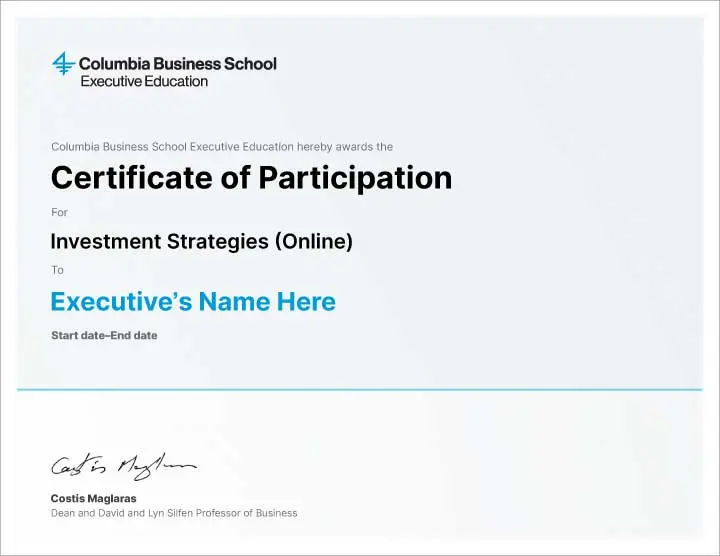Investment Strategies (Online)
Early Registration Benefit
Apply now to secure your place at Invalid liquid data byInvalid liquid data.
Connect with a learning advisor for more information.
Key Takeaways
The Investment Strategies (Online) program will enable you to:
Better inform your market opinions with a deeper understanding of capital markets, major investable asset classes, the challenges of leveraging and shorting, and how to use financial and economic databases
Avoid common investment pitfalls by gaining an understanding of overleveraging and underappreciating
Make educated stock selections by measuring risk and applying risk management and analytical theory to your choices
Become an active portfolio manager by analyzing the performance of investment products over time, understanding bond market and yield, and knowing the tools for — and limits of — forecasting
Who Should Attend
Retail investors, traders, or advanced individual investors looking for sophisticated/advanced techniques and models to make more informed and strategic investment decisions and manage their investment portfolio, potentially leading to better investment outcomes
Portfolio managers seeking strategic portfolio management techniques, equipping them with the strategies needed to construct robust investment portfolios and manage risks
Financial analysts and investment professionals looking for enhanced analytical skills that can significantly increase their analytical capabilities, making them more effective in their roles
Program Modules
Program Experience

World-Renowned Faculty
Learn from accomplished faculty, and industry experts whose diverse backgrounds encompass a broad range of disciplines

Peer Interaction
Stimulating discussions with like-minded global peers expand your professional network and build a supportive community

Case Studies
Through exploratory sessions, examine practical examples and find innovative solutions to strategic challenges

Engaging Assignments and Activities
Hone business acumen and executive skills with try-it activities that help you redefine your potential
Real-World Applications and Learning Activities
You’ll have access to a range of hands-on tools and activities that bridge the theoretical and the practical to help make you a more effective investor. Some examples include:
Hedge Fund Case Study Explore the real-world gains and perils that can occur when aggressively using leverage and risk in the investment process.
Measurement Tools Examine and apply different approaches for measuring investment performance — including risk exposure — using the Sharpe ratio and the information ratio.
Financial Data Resources Learn to use an invaluable set of online resources that can help you create an investment strategy and wisely implement it, such as Yahoo Finance, Finviz, MacroHistory and FRED.
Participant Testimonials


Program Faculty

Professor of Professional Practice, Director of the Program for Financial Studies, Columbia Business School

Certificate
Upon completion of the Investment Strategies (Online) program, you will receive a certificate of participation from Columbia Business School Executive Education. This certificate also awards two credits towards the Certificate in Business Excellence, which grants select alumni and tuition benefits. Learn More
Your digitally verified certificate will be issued in your legal name and emailed to you, at no additional cost, upon completion of the program, including all modules of the program (online, in person, or live online, inter-module). All certificate images are for illustrative purposes only and may be subject to change at the discretion of Columbia Business School Executive Education.
FAQs
Financing Options
Climb Credit*
We offer financing options with our partner, Climb Credit*. Click here to learn more. *Applicable for US Residents
Flexible Payment Options For All
Flexible payment options allow you to pay the program fee in installments. Click here to see payment schedule.
Didn't find what you were looking for? Write to us at learner.success@emeritus.org or Schedule a call with one of our Program Advisors or call us at +1 315 387 4431 (US) / +44 203 838 0836 (UK) / +65 3138 4449 (SG)
Early registrations are encouraged. Seats fill up quickly!
Flexible payment options available.
Starts On

